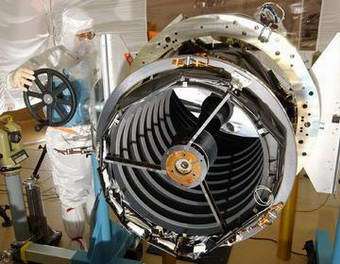Mars Orbiter Makes Successful Course Correction

NASA's Mars Reconnaissance Orbiter (MRO) successfully tested its main engines by making a successful trajectory adjustment for reaching the red planet on March 10, 2006.
The spacecraft fired all six main thrusters for 15 seconds on Saturday. The engine burn followed a 30-second burn of six smaller thrusters, which settled propellant in the craft’s fuel tank for smoother flow. The spacecraft’s orientation was adjusted prior to the burns to point the engines in the proper direction for the maneuver. The MRO returned to the regular cruise-phase attitude after the trajectory adjustment.
“This maneuver accomplished two goals at once,” said Mars Reconnaissance Orbiter Deputy Mission Manager Dan Johnston of NASA’s Jet Propulsion Laboratory (JPL), Pasadena, Calif. “It adjusted our trajectory toward our Mars target point, and it gave us a valuable checkout of the orbit-insertion engines.” The target point is 395 kilometers (245 miles) above the surface of Mars.
Initial analysis of navigational data indicates this first flight path correction successfully changed the spacecraft’s velocity by the intended 7.8 meters per second (17.4 mph). MRO's velocity relative to the sun is 32,856 meters per second (73,497 mph).
The six main engines won't be used again until the craft arrives at Mars. The next burn will last about 25 minutes. It will slow the MRO enough for the planet’s gravity to capture the spacecraft into orbit. Each main engine produces approximately 38 pounds of thrust. The three remaining opportunities scheduled for fine-tuning the trajectory before March will use smaller engines. Each smaller engine produces approximately five pounds of thrust.
“We intentionally designed the initial trajectory after launch with a bias in it, so this first correction maneuver would be large enough to let us use the main engines,” Johnston said.
The next milestone for the MRO mission is today. MRO will turn on its instruments to check their condition. The spacecraft was launched Aug. 12, and it is in excellent health. MRO has traveled approximately 6 million kilometers (3.7 million miles) since launch. It has 95.9 million kilometers (59.6 million miles) still to fly before reaching Mars.
The MRO mission will examine Mars in unprecedented detail from low orbit. Mission science objectives include studying water distribution, including ice, vapor or liquid; geologic features and minerals. It will also support future missions to Mars by examining potential landing sites and by providing a relay for communications back to Earth.
Source: NASA















